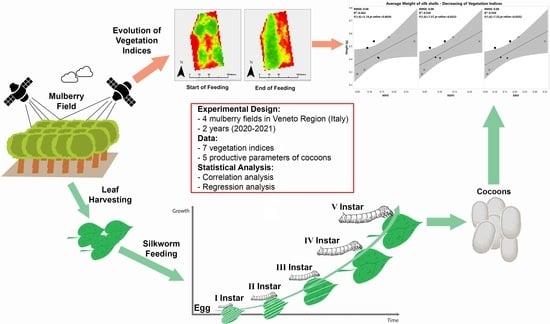Remote Sensing Imaging as a Tool to Support Mulberry Cultivation for Silk Production
Abstract
1. Introduction
2. Materials and Methods
2.1. Experimental Area Description
- High density: from 0.6 to 1.2 m in rows and 1.3 m between rows. This arrangement was represented by Field 02 and Field 04.
- Low density: 3.5 m in rows and 4 m between rows. This arrangement was represented by Field 01 and Field 03.
2.2. Silkworm Rearing
2.3. Data Acquisition and Analysis
2.3.1. Cocoon Yield Data Collection
- -
- Total production: This was the total production of cocoons from all reared boxes, per farmer and per year.
- -
- Production per box: This was calculated as total production/number of boxes.
- -
- Average cocoons weight: This was the average value of the individual weights of sampled cocoons.
- -
- Average silk shells weight: This was the average value of the individual weights of sampled cocoons after the removal of the pupae.
- -
- Average silk percentage: This was the average value of, calculated as silk shell weight/cocoon weight × 100.
2.3.2. Remote Sensing Data
- -
- Start of Feeding: This day marked the start of harvesting of mulberry leaves in the fields. This day corresponded to the first day of the third instar when the B. mori larvae were given to farmers.
- -
- Start of the fourth instar: The fourth larval instar of the silkworms began on this day.
- -
- Start of the fifth instar: The last larval instar of the silkworms began on this day.
- -
- End of Feeding: This was the last day of the fifth instar. The silkworm larvae stopped feeding on this day and began to spin cocoons.
2.4. Feature Extraction from Planet Data
- -
- Decreasing during third and fourth instars: The difference in values between the start of the fifth instar day and start of the feeding day was calculated. The authors determined the values corresponding to the first quartile, quart1st, by converting the resulting negative values (i.e., the points associated with a decrease in the selected vegetation index) into positive ones. The authors then calculated the average value avtot while excluding the values lower than quart1st, which were regarded as points with erratic variations in the vegetation index evolution. The measurement error was determined as the standard deviation of error, SDerr, from previously excluded values. This parameter thus represented the areas impacted by leaf harvesting during the third and fourth instars.
- -
- Decreasing during the fifth instar: This parameter was calculated in the same way as the previous one but by determining the differences in values of the end of feeding and the start of the fifth instar; the same data filtering and correction were applied. As a result, this parameter took into account only the points that represented the areas impacted by leaf harvesting during the fifth instar.
2.5. Statistical Analysis
3. Results and Discussion
3.1. Cocoon Parameters
3.2. Evolution of Vegetation Indices
3.3. Correlation Analysis between Vegetation Indices and Cocoon Production Parameters
3.4. Regression Analysis of Vegetation Indices and Silk Production Parameters
3.4.1. Production per Box
3.4.2. Average Weight of Cocoons
3.4.3. Average Weight of Silk Shell
3.4.4. Average Silk Percentage
4. Conclusions
Author Contributions
Funding
Data Availability Statement
Acknowledgments
Conflicts of Interest
References
- Lim, S.-H.; Kim, Y.-T.; Lee, S.-P.; Rhee, I.-J.; Lim, J.-S.; Lim, B.-H. Sericulture Training Manual; Food & Agriculture Org.: Rome, Italy, 1990; ISBN 9251029040. [Google Scholar]
- Resh, V.H.; Cardé, R.T. Encyclopedia of Insects; Academic Press: Cambridge, MA, USA, 2009; ISBN 008092090X. [Google Scholar]
- Lakshmanan, S. Yield gaps in mulberry sericulture in Karnataka: An Econometric Analysis. Indian J. Agric. Econ. 2007, 62, 902-2016-66784. [Google Scholar]
- Dobrowski, S.Z.; Ustin, S.L.; Wolpert, J.A. Remote estimation of vine canopy density in vertically shoot-positioned vineyards: Determining optimal vegetation indices. Aust. J. Grape Wine Res. 2002, 8, 117–125. [Google Scholar] [CrossRef]
- Gonzalez-Dugo, V.; Zarco-Tejada, P.; Berni, J.A.J.; Suárez, L.; Goldhamer, D.; Fereres, E. Almond tree canopy temperature reveals intra-crown variability that is water stress-dependent. Agric. For. Meteorol. 2012, 154–155, 156–165. [Google Scholar] [CrossRef]
- Khaliq, A.; Comba, L.; Biglia, A.; Ricauda Aimonino, D.; Chiaberge, M.; Gay, P. Comparison of satellite and UAV-based multispectral imagery for vineyard variability assessment. Remote Sens. 2019, 11, 436. [Google Scholar] [CrossRef]
- Dobrowski, S.Z.; Ustin, S.L.; Wolpert, J.A. Grapevine dormant pruning weight prediction using remotely sensed data. Aust. J. Grape Wine Res. 2003, 9, 177–182. [Google Scholar] [CrossRef]
- Hall, A.; Lamb, D.W.; Holzapfel, B.; Louis, J. Optical remote sensing applications in viticulture—A review. Aust. J. Grape Wine Res. 2002, 8, 36–47. [Google Scholar] [CrossRef]
- Liu, Z.; Guo, P.; Liu, H.; Fan, P.; Zeng, P.; Liu, X.; Feng, C.; Wang, W.; Yang, F. Gradient boosting estimation of the leaf area index of apple orchards in uav remote sensing. Remote Sens. 2021, 13, 3263. [Google Scholar] [CrossRef]
- Cohen, S.; Fuchs, M. The distribution of leaf area, radiation, photosynthesis and transpiration in a Shamouti orange hedgerow orchard. Part I. Leaf area and radiation. Agric. For. Meteorol. 1987, 40, 123–144. [Google Scholar] [CrossRef]
- Gitelson, A.A.; Merzlyak, M.N. Remote estimation of chlorophyll content in higher plant leaves. Int. J. Remote Sens. 1997, 18, 2691–2697. [Google Scholar] [CrossRef]
- Van Beek, J.; Tits, L.; Somers, B.; Deckers, T.; Janssens, P.; Coppin, P. Reducing background effects in orchards through spectral vegetation index correction. Int. J. Appl. Earth Obs. Geoinf. 2015, 34, 167–177. [Google Scholar] [CrossRef]
- Purohit, S.; Uniyal, D.; Kandwal, D.; Kimothi, M.M.; Pant, D. Site suitability analysis using geospatial techniques for identification of mulberry plantation sites: A case study of Dehradun district of Uttarakhand State. Int. J. Remote Sens. Geosci. 2015, 4, 28–31. [Google Scholar]
- Sozzi, M.; Kayad, A.; Gobbo, S.; Cogato, A.; Sartori, L.; Marinello, F.; Singh, V.; Huang, Y. Economic Comparison of Satellite, Plane and UAV-Acquired NDVI Images for Site-Specific Nitrogen Application: Observations from Italy. Agronomy 2021, 11, 2098. [Google Scholar] [CrossRef]
- Bannari, A.; Morin, D.; Bonn, F.; Huete, A.R. A review of vegetation indices. Remote Sens. Rev. 2009, 13, 95–120. [Google Scholar] [CrossRef]
- Chuvieco, E. Fundamentals of Satellite Remote Sensing: An Environmental Approach; CRC Press: Boca Raton, FL, USA, 2016; ISBN 1498728073. [Google Scholar]
- Cammarano, D.; Fitzgerald, G.J.; Casa, R.; Basso, B. Assessing the Robustness of Vegetation Indices to Estimate Wheat N in Mediterranean Environments. Remote Sens. 2014, 6, 2827–2844. [Google Scholar] [CrossRef]
- Atzberger, C. Object-based retrieval of biophysical canopy variables using artificial neural nets and radiative transfer models. Remote Sens. Environ. 2004, 93, 53–67. [Google Scholar] [CrossRef]
- Swain, K.C.; Thomson, S.J.; Jayasuriya, H.P.W. Adoption of an Unmanned Helicopter for Low-Altitude Remote Sensing to Estimate Yield and Total Biomass of a Rice Crop. Trans. ASABE 2010, 53, 21–27. [Google Scholar] [CrossRef]
- Espinoza, C.Z.; Khot, L.R.; Sankaran, S.; Jacoby, P.W. High resolution multispectral and thermal remote sensing-based water stress assessment in subsurface irrigated grapevines. Remote Sens. 2017, 9, 961. [Google Scholar] [CrossRef]
- Taghvaeian, S.; Chávez, J.L.; Hansen, N.C. Infrared Thermometry to Estimate Crop Water Stress Index and Water Use of Irrigated Maize in Northeastern Colorado. Remote Sens. 2012, 4, 3619–3637. [Google Scholar] [CrossRef]
- Rhee, J.; Im, J.; Carbone, G.J. Monitoring agricultural drought for arid and humid regions using multi-sensor remote sensing data. Remote Sens. Environ. 2010, 114, 2875–2887. [Google Scholar] [CrossRef]
- Klisch, A.; Atzberger, C. Operational Drought Monitoring in Kenya Using MODIS NDVI Time Series. Remote Sens. 2016, 8, 267. [Google Scholar] [CrossRef]
- Bolton, D.K.; Friedl, M.A. Forecasting crop yield using remotely sensed vegetation indices and crop phenology metrics. Agric. For. Meteorol. 2013, 173, 74–84. [Google Scholar] [CrossRef]
- Cilia, C.; Panigada, C.; Rossini, M.; Meroni, M.; Busetto, L.; Amaducci, S.; Boschetti, M.; Picchi, V.; Colombo, R. Nitrogen Status Assessment for Variable Rate Fertilization in Maize through Hyperspectral Imagery. Remote Sens. 2014, 6, 6549–6565. [Google Scholar] [CrossRef]
- Shanahan, J.F.; Schepers, J.S.; Francis, D.D.; Varvel, G.E.; Wilhelm, W.W.; Tringe, J.M.; Schlemmer, M.R.; Major, D.J. Use of remote-sensing imagery to estimate corn grain yield. Agron. J. 2001, 93, 583–589. [Google Scholar] [CrossRef]
- Dempewolf, J.; Adusei, B.; Becker-Reshef, I.; Hansen, M.; Potapov, P.; Khan, A.; Barker, B. Wheat Yield Forecasting for Punjab Province from Vegetation Index Time Series and Historic Crop Statistics. Remote Sens. 2014, 6, 9653–9675. [Google Scholar] [CrossRef]
- Hansen, P.M.; Jørgensen, J.R.; Thomsen, A. Predicting grain yield and protein content in winter wheat and spring barley using repeated canopy reflectance measurements and partial least squares regression. J. Agric. Sci. 2002, 139, 307–318. [Google Scholar] [CrossRef]
- Magney, T.S.; Eitel, J.U.H.; Huggins, D.R.; Vierling, L.A. Proximal NDVI derived phenology improves in-season predictions of wheat quantity and quality. Agric. For. Meteorol. 2016, 217, 46–60. [Google Scholar] [CrossRef]
- Saviane, A.; Toso, L.; Righi, C.; Pavanello, C.; Crivellaro, V.; Cappellozza, S. Rearing of monovoltine strains of Bombyx mori by alternating artificial diet and mulberry leaf accelerates selection for higher food conversion efficiency and silk productivity. Bull. Insectol. 2014, 67, 167–174. [Google Scholar]
- Planet Developers. Understanding Planet Scope Instruments. Available online: https://developers.planet.com/docs/apis/data/sensors/ (accessed on 21 June 2022).
- Rouse, W.J. Monitoring the Vernal Advancement of Retrogradation of Natural Vegetation; NASA/GSFC, Type III, Final Report; NASA: Greenbelt, MD, USA, 1974; p. 371. [Google Scholar]
- Huete, A.R. A soil-adjusted vegetation index (SAVI). Remote Sens. Environ. 1988, 25, 295–309. [Google Scholar] [CrossRef]
- Qi, J.; Chehbouni, A.; Huete, A.R.; Kerr, Y.H.; Sorooshian, S. A modified soil adjusted vegetation index. Remote Sens. Environ. 1994, 48, 119–126. [Google Scholar] [CrossRef]
- Kaufman, Y.J.; Tanré, D. Atmospherically Resistant Vegetation Index (ARVI) for EOS-MODIS. IEEE Trans. Geosci. Remote Sens. 1992, 30, 261–270. [Google Scholar] [CrossRef]
- Zhengxing, W.; Chuang, L.; Alfredo, H. From AVHRR-NDVI to MODIS-EVI: Advances in vegetation index research. Acta Ecol. Sin. 2003, 23, 979–987. [Google Scholar]
- Wang, F.; Huang, J.; Tang, Y.; Wang, X. New Vegetation Index and Its Application in Estimating Leaf Area Index of Rice. Rice Sci. 2007, 14, 195–203. [Google Scholar] [CrossRef]
- Schneider, P.; Roberts, D.A.; Kyriakidis, P.C. A VARI-based relative greenness from MODIS data for computing the Fire Potential Index. Remote Sens. Environ. 2008, 112, 1151–1167. [Google Scholar] [CrossRef]
- Kayad, A.; Sozzi, M.; Paraforos, D.S.; Rodrigues, F.A.; Cohen, Y.; Fountas, S.; Francisco, M.J.; Pezzuolo, A.; Grigolato, S.; Marinello, F. How many gigabytes per hectare are available in the digital agriculture era? A digitization footprint estimation. Comput. Electron. Agric. 2022, 198, 107080. [Google Scholar] [CrossRef]
- Zhang, X.; Friedl, M.A.; Schaaf, C.B.; Strahler, A.H.; Hodges, J.C.F.; Gao, F.; Reed, B.C.; Huete, A. Monitoring vegetation phenology using MODIS. Remote Sens. Environ. 2003, 84, 471–475. [Google Scholar] [CrossRef]
- Jönsson, P.; Eklundh, L. TIMESAT—A program for analyzing time-series of satellite sensor data. Comput. Geosci. 2004, 30, 833–845. [Google Scholar] [CrossRef]
- Sakamoto, T.; Yokozawa, M.; Toritani, H.; Shibayama, M.; Ishitsuka, N.; Ohno, H. A crop phenology detection method using time-series MODIS data. Remote Sens. Environ. 2005, 96, 366–374. [Google Scholar] [CrossRef]
- Mirhosseini, S.Z.; Ghanipoor, M.; Ahad Shadparvar, A.; Etebari, K.; Mirhosseini, S.Z.; Ghanipoor, M.; Shadparvar, A.; Etebari, K. Selection Indices for Cocoon Traits in Six Commercial Silkworm (Bombyx mori L.) Lines. Philipp. Agric. Sci. 2005, 88, 328–336. [Google Scholar]
- Awquib, S.; Malik, F.; Sofi, A.M.; Malik, M.A. Heritability, genetic advance and correlation analysis of some reproductive traits in silkworm, Bombyx mori L. J. Exp. Zool. India 2009, 12, 307–310. [Google Scholar]
- Long, N.V.; Petkov, N. Breeding—Genetic studies in some silkworm (Bombyx mori) breeds. I. Variability and correlations of quantitative characters. Genet. Sel. 1987, 20, 58–62. [Google Scholar]
- Singh, T.; Singh, K. Heritability and correlations between some economic characters in Bombyx mori (L.). Sci. Cult. 1993, 59, 51–52. [Google Scholar]
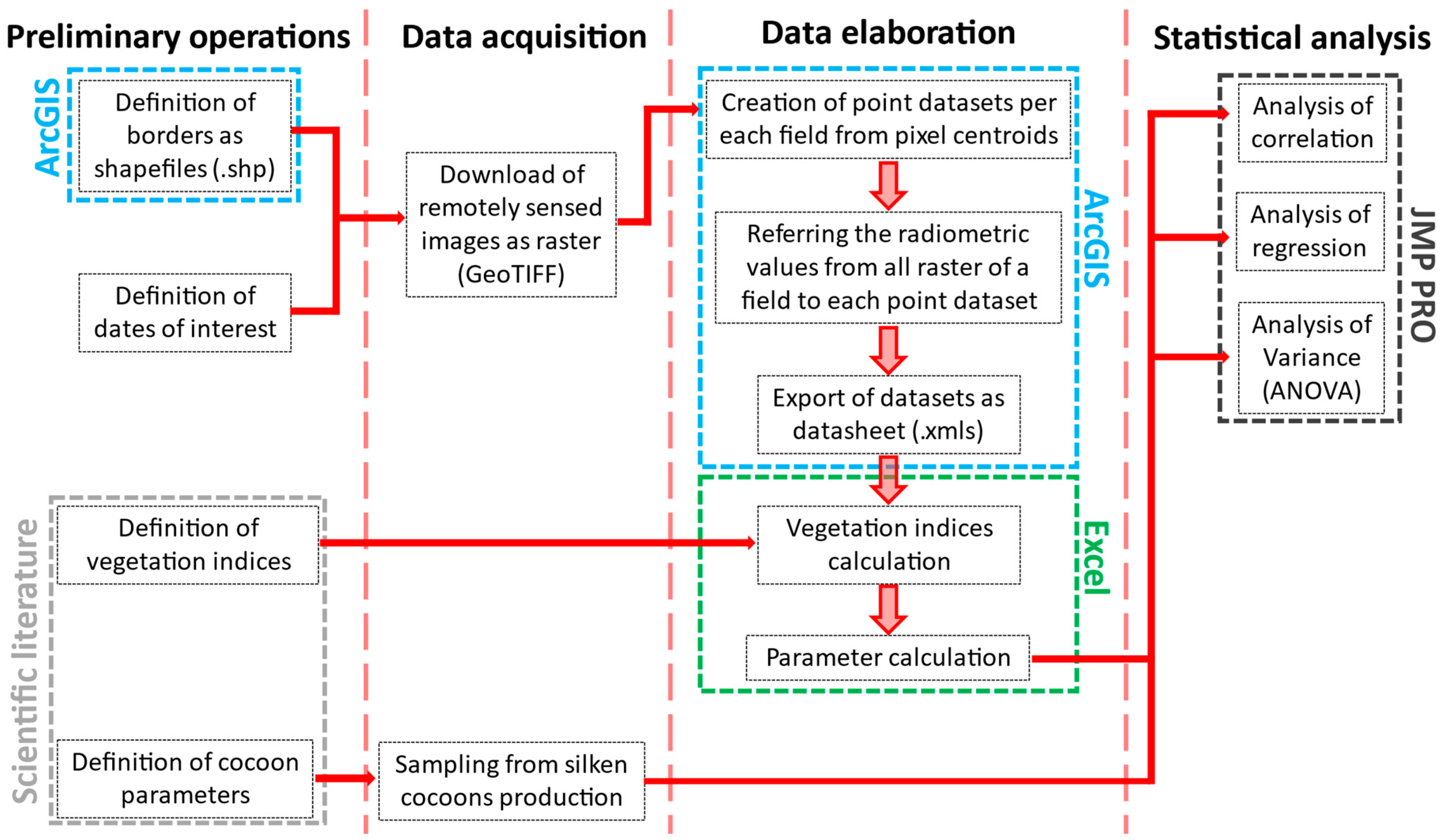

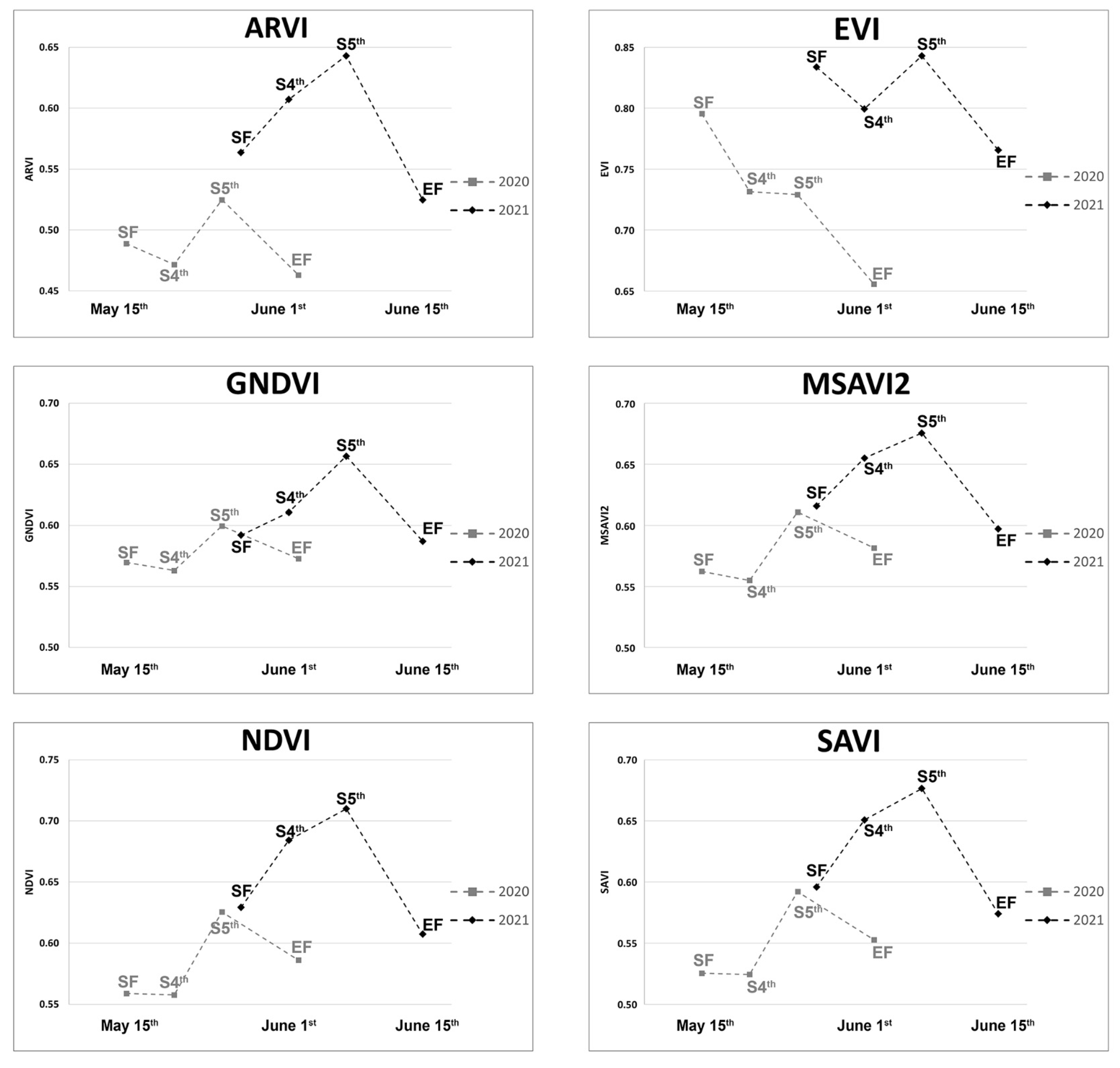

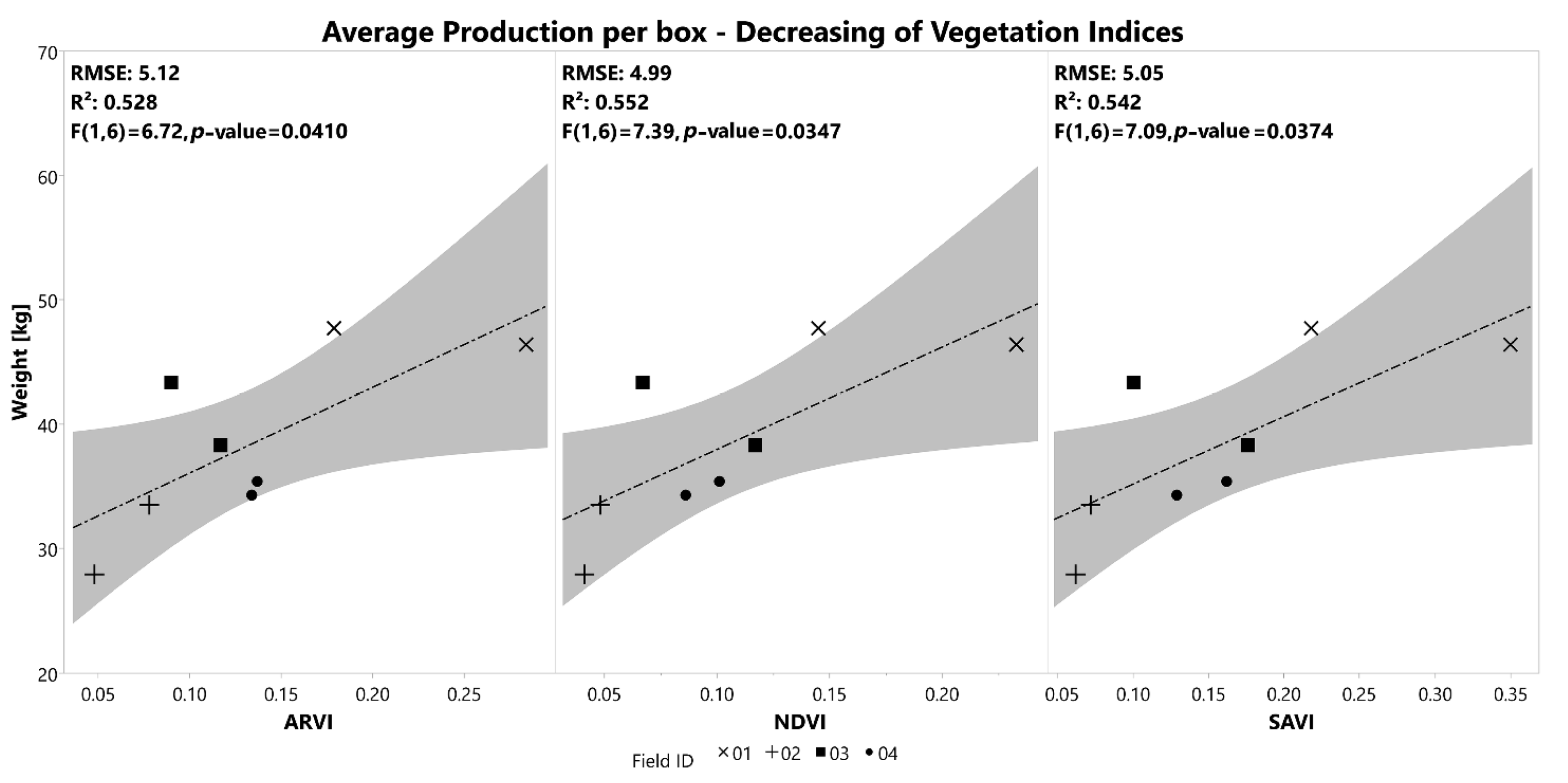
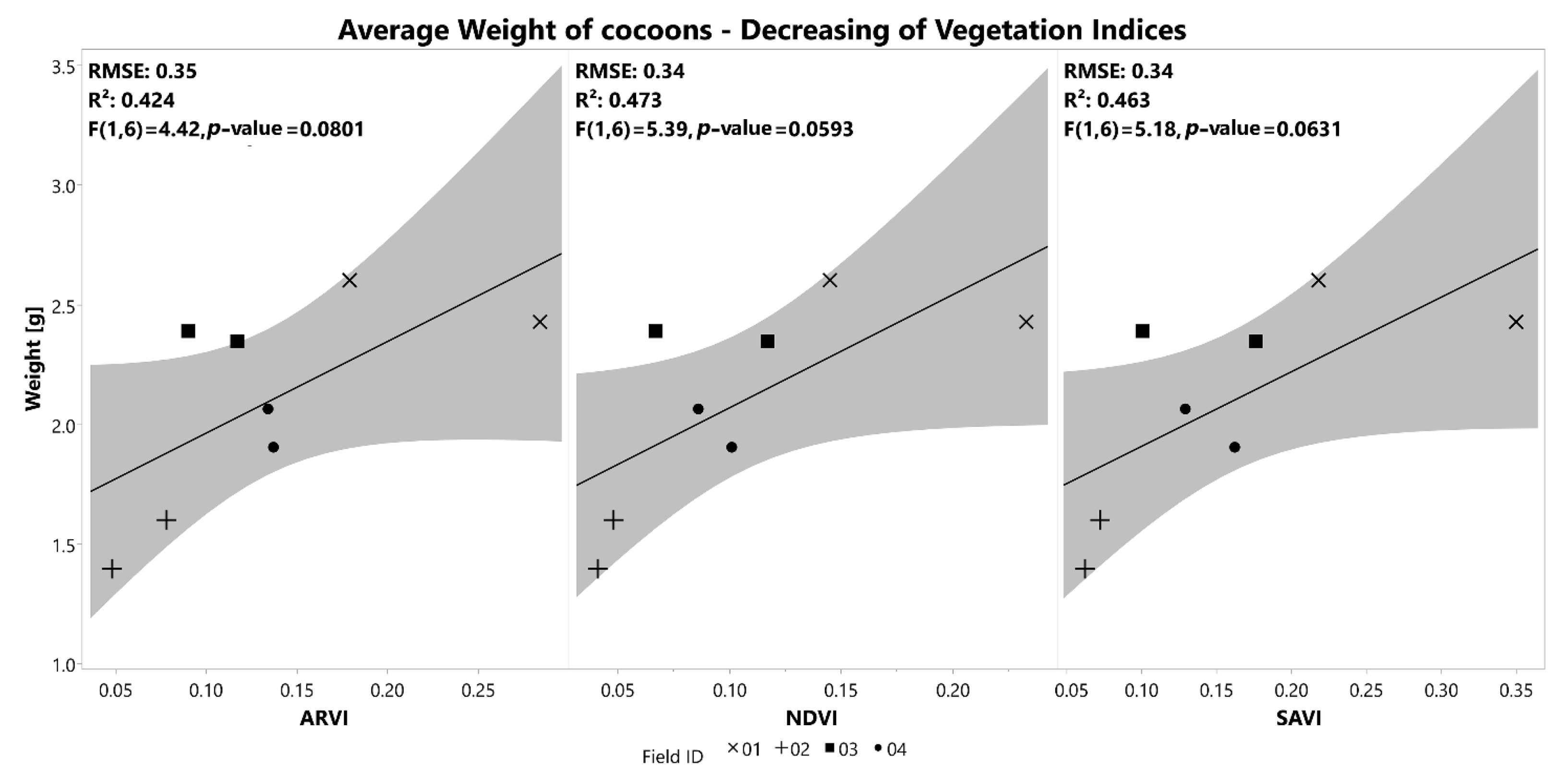


| Field ID | Spring 2020 | Spring 2021 | ||||||
|---|---|---|---|---|---|---|---|---|
| Start of Feeding | Start of 4th Instar | Start of 5th Instar | End of Feeding | Start of Feeding | Start of 4th Instar | Start of 5th Instar | End of Feeding | |
| 01 | 15 May | 20 May | 25 May | 2 June | 27 May | 1 June | 8 June | 15 June |
| 02 | 15 May | 21 May | 27 May | 2 June | 27 May | 1 June | 9 June | 13 June |
| 03 | 15 May | 20 May | 25 May | 2 June | 27 May | 1 June | 6 June | 13 June |
| 04 | 15 May | 20 May | 25 May | 2 June | 27 May | 1 June | 9 June | 17 June |
| Index | Reference | Range |
|---|---|---|
| Atmospherically Resistant Vegetation Index (ARVI) | Kaufman and Tanré [35] | (−1, +1) |
| Enhanced Vegetation Index (EVI) | Wang et al. [36] | (−1, +1) |
| Green Normalized Difference Vegetation Index (GNDVI) | Wang et al. [37] | (−1, +1) |
| Modified Soil Adjusted Vegetation Index (MSAVI2) | Qi et al. [34] | (−1, +1) |
| Normalized Difference Vegetation Index (NDVI) | Rouse et al. [32] | (−1, +1) |
| Soil Adjusted Vegetation Index (SAVI) | Huete [33] | (−1, +1) |
| Visual Atmosphere Resistance Index (VARI) | Schneider et al. [38] | (−1, +1) |
| Field ID | Years |
Number of Boxes | Total Production [kg] | Production per Box [kg/Box] |
|---|---|---|---|---|
| 01 | 2020 | 2 | 95.42 | 47.71 |
| 2021 | 2 | 92.77 | 46.39 | |
| 02 | 2020 | 1 | 27.94 | 27.94 |
| 2021 | 1 | 33.51 | 33.51 | |
| 03 | 2020 | 3 | 130.01 | 43.34 |
| 2021 | 4 | 153.21 | 38.30 | |
| 04 | 2020 | 3 | 102.90 | 34.30 |
| 2021 | 1 | 35.40 | 35.40 |
| Field ID | Years | Av. Cocoon Weight ± SD [g] | Av. Silk Shell Weight ± SD [g] | Av. Silk Ratio ± SD [%] |
|---|---|---|---|---|
| 01 | 2020 | 2.620 ± 0.379 a | 0.570 ± 0.075 a | 22.0 ± 1.8 a |
| 2021 | 2.429 ± 0.367 ab | 0.538 ± 0.054 a | 22.5 ± 2.8 a | |
| 02 | 2020 | 1.397 ± 0.221 d | 0.283 ± 0.050 d | 20.3 ± 1.4 b |
| 2021 | 1.601 ± 0.279 d | 0.316 ± 0.055 d | 19.9 ± 2.6 b | |
| 03 | 2020 | 2.389 ± 0.330 ab | 0.487 ± 0.067 b | 20.4 ± 1.3 b |
| 2021 | 2.347 ± 0.395 b | 0.538 ± 0.078 a | 23.2 ± 3.1 a | |
| 04 | 2020 | 2.065 ± 0.302 c | 0.413 ± 0.047 c | 20.2 ± 2.0 b |
| 2021 | 1.905 ± 0.267 c | 0.408 ± 0.045 c | 21.7 ± 2.6 ab |
| Third + Fourth Instars | Fifth Instar | ||||||
|---|---|---|---|---|---|---|---|
| Field ID | Years | quart1st | avtot | SDerr | quart1st | avtot | SDerr |
| 01 | 2020 | 0.005 | 0.024 | 0.001 | 0.074 | 0.145 | 0.022 |
| 2021 | <0.001 | <0.001 | <0.001 | 0.152 | 0.233 | 0.038 | |
| 02 | 2020 | 0.009 | 0.028 | 0.003 | 0.015 | 0.041 | 0.004 |
| 2021 | 0.007 | 0.020 | 0.002 | 0.024 | 0.048 | 0.006 | |
| 03 | 2020 | 0.015 | 0.032 | <0.001 | 0.013 | 0.036 | 0.004 |
| 2021 | 0.004 | 0.018 | 0.001 | 0.089 | 0.117 | 0.007 | |
| 04 | 2020 | 0.010 | 0.048 | 0.003 | 0.039 | 0.086 | 0.011 |
| 2021 | 0.022 | 0.059 | 0.015 | 0.045 | 0.101 | 0.031 | |
| Parameter | Production per Box | Cocoons Weight | Silk Shell Weight | Silk Ratio | Date | ARVI | EVI | GNDVI | MSAVI2 | NDVI | SAVI | VARI |
|---|---|---|---|---|---|---|---|---|---|---|---|---|
| Total production | 0.57 ns | 0.80 ** | 0.78 ** | 0.49 ns | Start of feeding | 0.15 | −0.13 | 0.27 | 0.19 | 0.18 | 0.18 | −0.17 |
| Start of the 4th instar | 0.35 | 0.31 | 0.44 | 0.39 | 0.37 | 0.37 | 0.12 | |||||
| Start of the 5th instar | 0.51 | 0.36 | 0.54 | 0.54 | 0.54 | 0.54 | 0.44 | |||||
| End of feeding | 0.38 | 0.32 | 0.41 | 0.38 | 0.38 | 0.38 | 0.20 | |||||
| Decreasing during the 5th instar | 0.25 | −0.10 | 0.10 | 0.19 | 0.34 | 0.32 | −0.12 | |||||
| Production per box | - | 0.93 *** | 0.90 *** | 0.55 ns | Start of feeding | −0.13 | 0.01 | −0.08 | −0.10 | −0.13 | −0.13 | −0.26 |
| Start of the 4th instar | 0.11 | 0.11 | 0.13 | 0.18 | 0.13 | 0.13 | 0.01 | |||||
| Start of the 5th instar | 0.23 | 0.21 | 0.36 | 0.24 | 0.19 | 0.19 | −0.16 | |||||
| End of feeding | −0.03 | −0.05 | −0.10 | −0.04 | −0.05 | −0.05 | 0.02 | |||||
| Decreasing during the 5th instar | 0.73 ** | 0.49 | 0.68 * | 0.71 ** | 0.74 ** | 0.74 ** | −0.05 | |||||
| Cocoons weight | - | - | 0.98 *** | 0.64 * | Start of feeding | 0.05 | −0.06 | 0.16 | 0.09 | 0.07 | 0.07 | −0.23 |
| Start of the 4th instar | 0.26 | 0.27 | 0.33 | 0.32 | 0.27 | 0.27 | 0.06 | |||||
| Start of the 5th instar | 0.42 | 0.32 | 0.55 | 0.44 | 0.41 | 0.41 | 0.09 | |||||
| End of feeding | 0.19 | 0.14 | 0.14 | 0.18 | 0.18 | 0.18 | 0.19 | |||||
| Decreasing during the 5th instar | 0.65 * | 0.34 | 0.55 | 0.6 | 0.69 * | 0.68 * | −0.08 | |||||
| Silk Shell weight | - | - | - | 0.77 ** | Start of feeding | 0.05 | −0.12 | 0.14 | 0.09 | 0.08 | 0.08 | −0.14 |
| Start of the 4th instar | 0.27 | 0.29 | 0.29 | 0.31 | 0.27 | 0.27 | 0.12 | |||||
| Start of the 5th instar | 0.40 | 0.29 | 0.57 | 0.43 | 0.41 | 0.40 | 0.06 | |||||
| End of feeding | 0.15 | 0.13 | 0.10 | 0.13 | 0.13 | 0.13 | 0.13 | |||||
| Decreasing during the 5th instar | 0.68 * | 0.30 | 0.61 | 0.66 * | 0.75 ** | 0.74 ** | −0.18 | |||||
| Silk Percentage | - | - | - | - | Start of feeding | 0.12 | −0.17 | 0.11 | 0.14 | 0.15 | 0.15 | 0.24 |
| Start of the 4th instar | 0.27 | 0.35 | 0.16 | 0.23 | 0.24 | 0.24 | 0.37 | |||||
| Start of the 5th instar | 0.32 | 0.15 | 0.55 | 0.34 | 0.35 | 0.35 | 0.03 | |||||
| End of feeding | 0.06 | 0.16 | <0.01 | −0.02 | <0.01 | <0.01 | <0.01 | |||||
| Decreasing during the 5th instar | 0.61 | 0.10 | 0.63 * | 0.68 * | 0.74 ** | 0.75 ** | −0.35 |
Publisher’s Note: MDPI stays neutral with regard to jurisdictional claims in published maps and institutional affiliations. |
© 2022 by the authors. Licensee MDPI, Basel, Switzerland. This article is an open access article distributed under the terms and conditions of the Creative Commons Attribution (CC BY) license (https://creativecommons.org/licenses/by/4.0/).
Share and Cite
Giora, D.; Assirelli, A.; Cappellozza, S.; Sartori, L.; Saviane, A.; Marinello, F.; Martínez-Casasnovas, J.A. Remote Sensing Imaging as a Tool to Support Mulberry Cultivation for Silk Production. Remote Sens. 2022, 14, 5450. https://doi.org/10.3390/rs14215450
Giora D, Assirelli A, Cappellozza S, Sartori L, Saviane A, Marinello F, Martínez-Casasnovas JA. Remote Sensing Imaging as a Tool to Support Mulberry Cultivation for Silk Production. Remote Sensing. 2022; 14(21):5450. https://doi.org/10.3390/rs14215450
Chicago/Turabian StyleGiora, Domenico, Alberto Assirelli, Silvia Cappellozza, Luigi Sartori, Alessio Saviane, Francesco Marinello, and José A. Martínez-Casasnovas. 2022. "Remote Sensing Imaging as a Tool to Support Mulberry Cultivation for Silk Production" Remote Sensing 14, no. 21: 5450. https://doi.org/10.3390/rs14215450
APA StyleGiora, D., Assirelli, A., Cappellozza, S., Sartori, L., Saviane, A., Marinello, F., & Martínez-Casasnovas, J. A. (2022). Remote Sensing Imaging as a Tool to Support Mulberry Cultivation for Silk Production. Remote Sensing, 14(21), 5450. https://doi.org/10.3390/rs14215450








